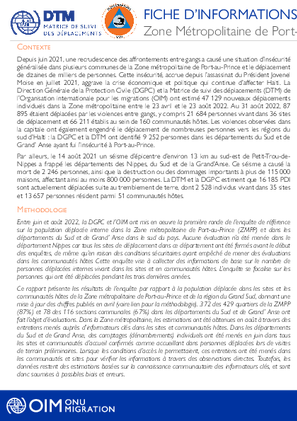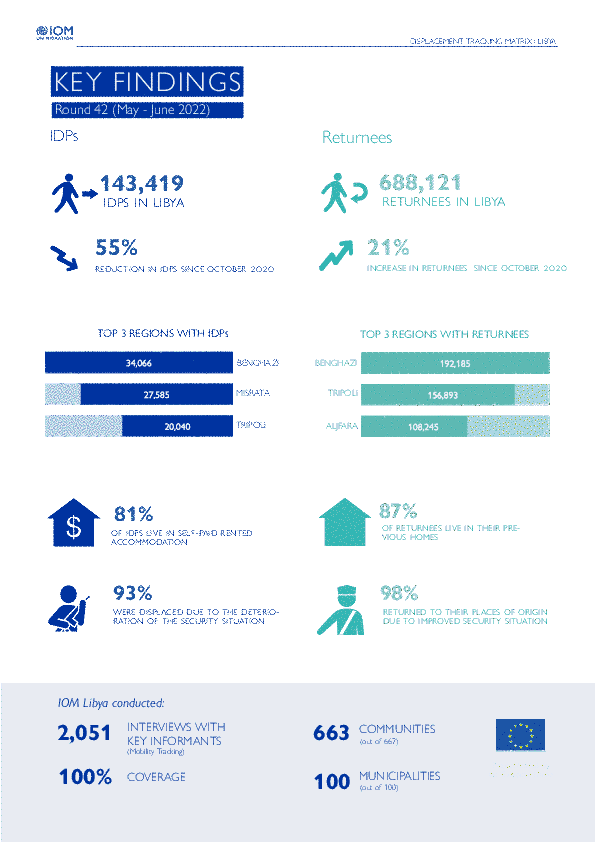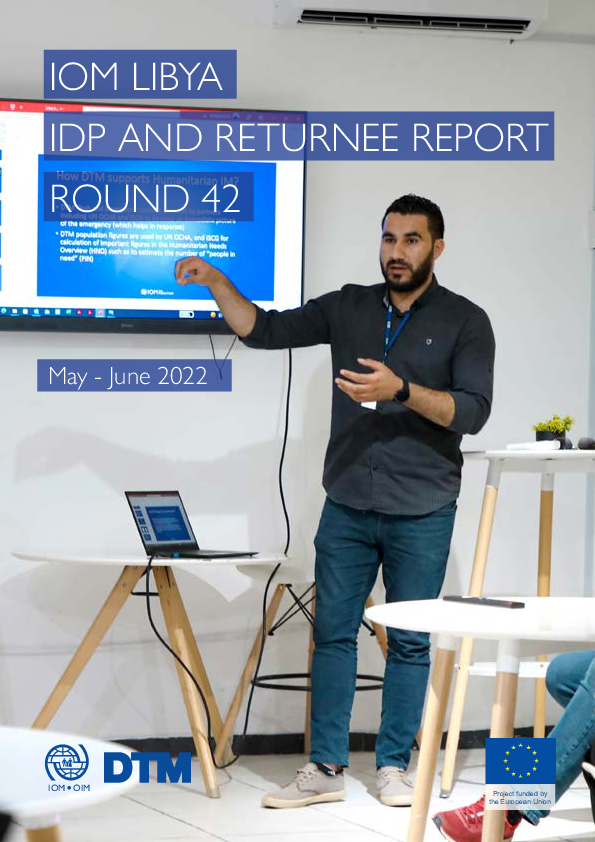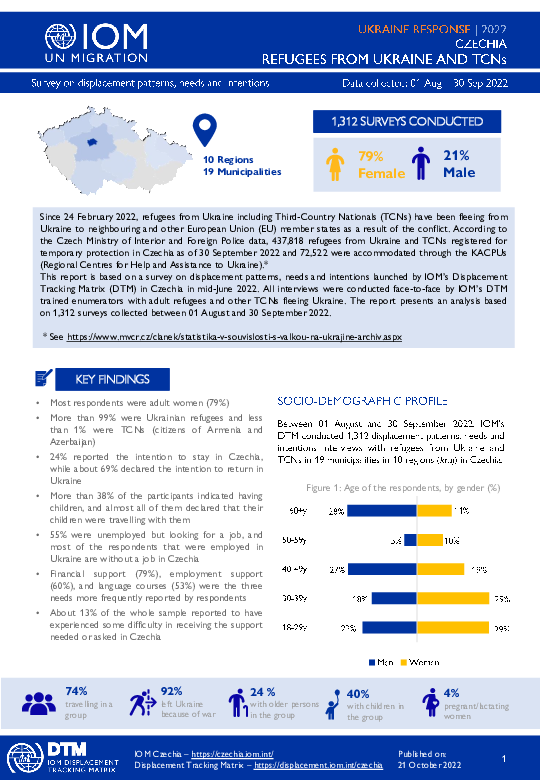-
Countries
-
Data and Analysis
-
Special Focus
-
Crisis Responses

Contact
DTM Haiti, dtmhaiti@iom.int
Language
English
Location
Haiti
Period Covered
Jun 01 2022
Aug 31 2022
Activity
- Mobility Tracking
- Baseline Assessment
Since June 2021, an upsurge in violent confrontations between gangs has generated a situation of
generalized insecurity in several communes of the Metropolitan Area of Port-au-Prince (ZMPP)
and displaced tens of thousands of people. Insecurity in the capital, which accelerated following the
assassination of President Jovenel Moïse in July 2021, has aggravated the already dire economic and
political conditions confronting Haiti. The Haitian Directorate-General for Civil Protection (Direction
Générale de la Protection Civile, DGPC) and IOM’s Displacement Monitoring Matrix (DTM) recorded
47,129 new displacement movements in the ZMPP between 23 April and 23 August 2022.
As of 31 August 2022 in the ZMPP, 87,895 individuals have been displaced by gang violence, including
21,684 in 36 spontaneous sites and 66,211 in 160 host communities/neighbourhoods. Violence
in the capital also prompted large numbers of people to flee to the southern regions of Haiti: the
DGPC and DTM identified 9,252 individuals amongst 51 host communities in the Sud and Grand’
Anse départements displaced by insecurity in the capital.
On 14 August 2021 an earthquake with an epicenter approximately 13 km southeast of Petit-Trou
de Nippes struck the departments of Nippes, South and Grand’Anse. This earthquake caused the
death of 2,246 people, as well as significant damage and destruction to more than 115,000 homes,
and affected over 800,000 people. IOM’s DTM and the DGPC estimate that 16,185 are currently
displaced in the departments of Sud and Grand Anse as a result of the earthquake, including 2,528
in 35 sites and 13,657 in 51 host communal sectors.

Contact
DTM Haiti, dtmhaiti@iom.int
Language
French
Location
Haiti
Period Covered
Jun 01 2022
Aug 31 2022
Activity
- Mobility Tracking
- Baseline Assessment
Depuis juin 2021, une recrudescence des affrontements entre gangs a causé une situation d’insécurité
généralisée dans plusieurs communes de la Zone métropolitaine de Port-au-Prince et le déplacement
de dizaines de milliers de personnes. Cette insécurité, accrue depuis l’assassinat du Président Jovenel
Moise en juillet 2021, aggrave la crise économique et politique qui continue d’affecter Haiti. La
Direction Générale de la Protection Civile (DGPC) et la Matrice de suivi des déplacements (DTM) de
l’Organisation internationale pour les migrations (OIM) ont estimé 47 129 nouveaux déplacements
individuels dans la Zone métropolitaine entre le 23 avril et le 23 août 2022. Au 31 Août 2022,
87 895 étaient déplacées par les violences entre gangs, y compris 21 684 personnes vivant dans 36
sites de déplacement et 66 211 établis au sein de 160 communautés hôtes. Les violences observées
dans la capitale ont également engendré le déplacement de nombreuses personnes vers les régions
du sud d’Haïti : la DGPC et la DTM ont identifié 9 252 personnes dans les départements du Sud et
de Grand’ Anse ayant fui l’insécurité à Port-au-Prince.
Par ailleurs, le 14 août 2021 un séisme d’épicentre d’environ 13 km au sud-est de Petit-Trou-de-
Nippes a frappé les départements des Nippes, du Sud et de la Grand’Anse. Ce séisme a causé la
mort de 2 246 personnes, ainsi que la destruction ou des dommages importants à plus de 115 000
maisons, affectant ainsi au moins 800 000 personnes. La DTM et la DGPC estiment que 16 185 PDI
sont actuellement déplacées suite au tremblement de terre, dont 2 528 individus vivant dans 35 sites
et 13 657 personnes résident parmi 51 communautés hôtes.
Contact
dtmlibya@iom.int
Location
Libya
Activity
- Mobility Tracking
- Baseline Assessment
Period Covered
May 01 2022 -Jun 30 2022
A baseline assessment is a sub-component of mobility tracking. It aims to collect data on IDP, migrant or returnee population presence in a defined administrative area of the country.
Population Groups
Survey Methodology
Unit of Analysis Or Observation
Type of Survey or Assessment
Keywords
Geographical Scope
Administrative boundaries with available data
The current dataset covers the following administrative boundaries

Contact
DTM Haiti, dtmhaiti@iom.int
Language
English
Location
Haiti
Period Covered
Jun 01 2022
Aug 31 2022
Activity
- Mobility Tracking
- Baseline Assessment
Since June 2021, an upsurge in violent confrontations between gangs has generated a situation of
generalized insecurity in several communes of the Metropolitan Area of Port-au-Prince (ZMPP)
and displaced tens of thousands of people. Insecurity in the capital, which accelerated following
the assassination of President Jovenel Moïse in July 2021, has aggravated the already dire economic
and political conditions confronting Haiti. The Haitian Directorate-General for Civil Protection
(Direction Générale de la Protection Civile, DGPC) and IOM’s Displacement Monitoring Matrix
(DTM) recorded 47,129 new displacement movements in the ZMPP between 23 April and 23
August 2022. As of 31 August 2022, 66,211 people (15,492 households) remain displaced
in 160 host communities/neighbourhoods in the ZMPP. Violence in the capital also prompted
large numbers of people to flee to the southern regions of Haiti: the DGPC and DTM identified
9,252 individuals in the Sud and Grand’ Anse départements displaced by insecurity in the capital.
On 14 August 2021 an earthquake with an epicenter approximately 13 km southeast of Petit-
Trou de Nippes struck the departments of Nippes, South and Grand’Anse. This earthquake
caused the death of 2,246 people, as well as significant damage and destruction to more than
115,000 homes, and affected over 800,000 people. IOM’s DTM and the DGPC estimate that
13,657 people in 51 host communities in the départements of Sud and Grand’ Anse are currently
displaced as a result of the earthquake.
The DGPC and DTM thus identified a total of 89,370 individuals (21,354 households) residing
amongst host communities in Haiti. The considerable majority of IDPs living in host communities
(83%) fled urban violence afflicting the ZMPP, while a smaller share (16%) - mainly in Sud and
Grand Anse - were displaced by disasters. Notably, half (50%) of IDPs living in host communities
in Grand’ Anse and 20 per cent in Sud fled gang related violence afflicting Port-au-Prince.

Contact
DTM Haiti, dtmhaiti@iom.int
Language
French
Location
Haiti
Period Covered
Jun 01 2022
Aug 31 2022
Activity
- Mobility Tracking
- Baseline Assessment
Depuis juin 2021, une recrudescence des affrontements entre gangs a causé une situation
d’insécurité généralisée dans plusieurs communes de la Zone métropolitaine de Port-au-Prince
et le déplacement de dizaines de milliers de personnes. Cette insécurité, accrue depuis l’assassinat
du Président Jovenel Moïse en juillet 2021, aggrave la crise économique et politique qui continue
d’affecter Haiti. La Direction Générale de la Protection Civile (DGPC) et la Matrice de suivi des
déplacements (DTM) de l’Organisation internationale pour les migrations (OIM) ont estimé 47
129 nouveaux déplacements individuels dans la Zone métropolitaine entre le 23 avril et le 23
août 2022. Au 31 Août 2022, 66 211 personnes (15 492 ménages) restent déplacées
au sein de 160 communautés hôtes/quartiers dans la ZMPP. Les violences observées dans la
capitale ont également engendré le déplacement de nombreuses personnes vers les régions du
sud d’Haïti : la DGPC et la DTM ont identifié 9 252 personnes dans les départements du Sud et
de Grand’ Anse ayant fui l’insécurité à Port-au-Prince.
Par ailleurs, le 14 août 2021 un séisme d’épicentre d’environ 13 km au sud-est de Petit-Troude-
Nippes a frappé les départements des Nippes, du Sud et de la Grand’Anse. Ce séisme a causé
la mort de 2 246 personnes, ainsi que la destruction ou des dommages importants à plus de
115 000 maisons, affectant ainsi au moins 800 000 personnes. La DTM et la DGPC estiment
que 13 657 PDI vivant parmi 51 communautés hôtes sont actuellement déplacées à la suite du
tremblement de terre.
Au total, la DGPC et la DTM ont identifié 89 370 personnes déplacées internes (21 354 ménages)
vivant au sein de communautés hôtes. La grande majorité des PDI vivant dans des communautés
d’accueil (83%) ont fui les violences touchant la ZMPP, tandis que 16 pour cant des personnes
déplacées – principalement dans le Sud et Grand’ Anse- ont été déplacées par des catastrophes.
Il est à noter que la moitié (50%) des PDI vivant dans des communautés hôtes du département
de Grand’ Anse et 20 pour cent des PDI dans le département du Sud ont quitté la ZMPP en
raison des violences liées aux gangs à Port-au-Prince.

Contact
DTM Libya, DTMLibyateam@iom.int
Language
English
Location
Libya
Period Covered
May 01 2022
Jun 30 2022
Activity
- Mobility Tracking
- Baseline Assessment
This infographic presents the key findings of Round 42 of the mobility tracking component of the Displacement Tracking Matrix (DTM) programme in Libya.

Contact
DTM Libya, DTMLibyateam@iom.int
Language
English
Location
Libya
Period Covered
May 01 2022
Jun 30 2022
Activity
- Mobility Tracking
- Baseline Assessment
This IOM Displacement Tracking Matrix (DTM) report presents the data and findings on internally displaced persons (IDPs) and returnees between May – June 2022, representing round 42 of the DTM Mobility Tracking in Libya. The number of people internally displaced (IDPs) in Libya continued to decrease during the reporting period as 143,419 individuals (29,194 families) were identified to be displaced by June 2022 compared to 159,996 IDPs identified in the previous round. By June 2022, a total of 688,121 individuals previously displaced were reported to have returned to their places of origin in 56 municipalities that had been previously affected by armed conflict or insecurity.

Contact
DTMcovid19@iom.int
Language
English
Location
Global
Period Covered
Oct 10 2022
Oct 17 2022
Activity
- Other
The DTM Global Mobility Restrictions Overview provides updates on international air travel restrictions and conditions for authorized entry. This overview aims to understand how COVID-19 has impacted human mobility, detailing how global and regional trends in air travel measures have evolved since COVID-19 was declared a global pandemic in March 2020. The data presented focuses on the changes in public health-related immigration and border management measures. It provides information intended to support IOM missions and partners in targeted response planning and advocacy for vulnerable populations who may be affected by changes in global mobility.

Contact
DTM Europe, DTMMediterranean@iom.int
Language
English
Location
Czechia
Period Covered
Aug 01 2022
Sep 30 2022
Activity
- Survey
- Flow Monitoring
Since 24 February 2022, refugees from Ukraine including Third-Country Nationals (TCNs) have been fleeing from Ukraine to neighbouring and other European Union (EU) member states as a result of the conflict. According to the Czech Ministry of Interior and Foreign Police data, 437,818 refugees from Ukraine and TCNs registered for temporary protection in Czechia as of 30 September 2022 and 72,522 were accommodated through the KACPUs (Regional Centres for Help and Assistance to Ukraine).*
This report is based on a survey on displacement patterns, needs and intentions launched by IOM’s Displacement Tracking Matrix (DTM) in Czechia in mid-June 2022. All interviews were conducted face-to-face by IOM’s DTM trained enumerators with adult refugees and other TCNs fleeing Ukraine. The report presents an analysis based on 1,312 surveys collected between 01 August and 30 September 2022.
* See https://www.mvcr.cz/clanek/statistika-v-souvislosti-s-valkou-na-ukrajine-archiv.aspx